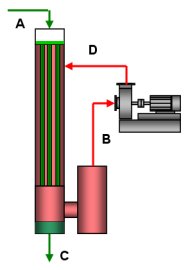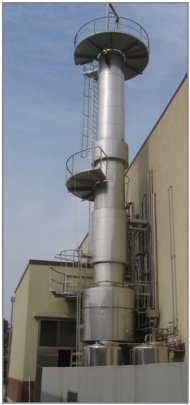|
Evaporation is a unit operation concentrating the solute in the solution by evaporating the solvent.The evaporation takes place by indirect heat transfer across a barrier between heat source and sink. For the continuous evapoartion, it is required that
- heat exchange surface exists between heat source (normally condensation) and evaporation
- condensing temperature is higher than evaporating temperature
- solvent vapor and concentrated solution are to be effectively separated
- evaporated solvent is readily evacuated to maintain the constant vapor pressure.
|
|

| Heat transfer rate |
| Q = U*A*△T |
|
|
| Temperature profile |
| △T = Td - Tc |
| = Td - (Tb + T BPR ) |
|
|
The left diagram illustrates flow streams around the falling film evaporatorThe feed solution ("A") is evenly distributed to vertical tubes by specially designed distribution bowl to guarantee sufficient and uniform film thickness through out the whole tube length. The heating vapor ("D") is condensed along the outer wall of vertical tubes by emitting latent heat to the solution to be evaporated. The vapor condensate ("E") is captured to reuse for preheating the feed. The evaporated solution and vapor mixture rush down to the bottom to be seperated to solvent vapor ("B") and concentrated solution ("C"). |
| |
Material Balance
| A = B + C |
A*Xf = C*Xc |
Xf : Solute concentration in feed |
|
| |
Heat Balance
| A*Cpf*Tf + D*Hd = C*Cpc*Tc + B*Hb + E*Cpe*Te |
| Cp : Specific heat |
Subscript |
f : feed |
| H : Enthalpy |
|
c : concentrate |
| T : Temperature |
|
d : heating vapor |
|
|
b : evaporated vapor |
|
|
e : condensate |
| U : Heat transfer coefficient |
A : Heat transfer area |
| △T : Temperature difference between heat sorce and evaporation |
| |
| TBPR : Boiling point rise |
|
Since 1970s, energy cost of the evaporation process comes to a crucial issue to plant process design engineers that efforts to reduce the heating vapor consumption have been highlighted. To understand the material and heat balance equation to an industrial aspect, we can approximate from the practices that enthalpy of the liquids are balanced as Hf ≒ (0.96∼0.98) * (Hc + He) which requires the vapor balance to be (0.96∼0.98) * Hd = Hb. If we take an account to bigger latent heat of low pressure evaporated vapor than heating vapor by 2% and radiation loss of around 3%, we could generalize the required heating vapor mass flow rate must be accordingly 8% higher than the evaporated vapor mass flow rate. A rule of thumb in the industrial sites calculates 10% higher heating vapor than the evaporation rate. The above mentioned approach is effective for only single effect evaporator, which is seldom in the industrial application for evaporation rate higher than 2 ton/h that multi-effect up to 10-effect becomes economically attractive by deviding effective △T profile of 30∼50℃ between 1st effect and condenser. |
|
|
To be more general, when we plan the multi-effect evaporator, one can say that 2-effects evaporator can reduce heating vapor consumption to a half and 3-effects can reduce down to one third. |
|
| |
| The above illustrated 4-effect falling film evaporator was designed for concentration of caprolactam water solution from A = 22,300 kg/h to C = 10,700 kg/h evaporating total vapor of B =11,600 kg/h. A rule of thumb calculates 12,500 kg/h steam consumption as an initial indication. By installing this 4-effect design in the year 2000, steam consumption is reduced to 3,500 kg/h which is 28% of single effect design. Thanks to this successful operation, second order for total evaporation of 32,644 kg/h that is about 3 times bigger will be installed in December, 2009. |
|
|
 |
The evaporated vapor "B" has a high enthalpy levelthanks to it's latent heat emitting to low temperature heat sink when it is condensed, however, temperature of "B" is not higher than solution "C" that heat transfer cannot be realized through tube walls. Thus MVR is introduced to compress vapor "B" adiabatically to raise temperature of heating vapor "D" by 7∼10℃ at each stage. |
 |
| We have an experience to compress 88℃ suction vapor up to 124℃ saturated vapor by 4-stage MVR, that is the first reference worldwide.The economy of installing MVR is so outstanding when we pay a cost so outstanding |
|
|
|
when we pay a cost of 10∼15 KW electric power to get 1 ton of heating steam, when we are paying $ 25 per ton of steam. This will offer us that 2 ton/h vapor evaporation is already economically atractive to consider MVR. |
|
| |


